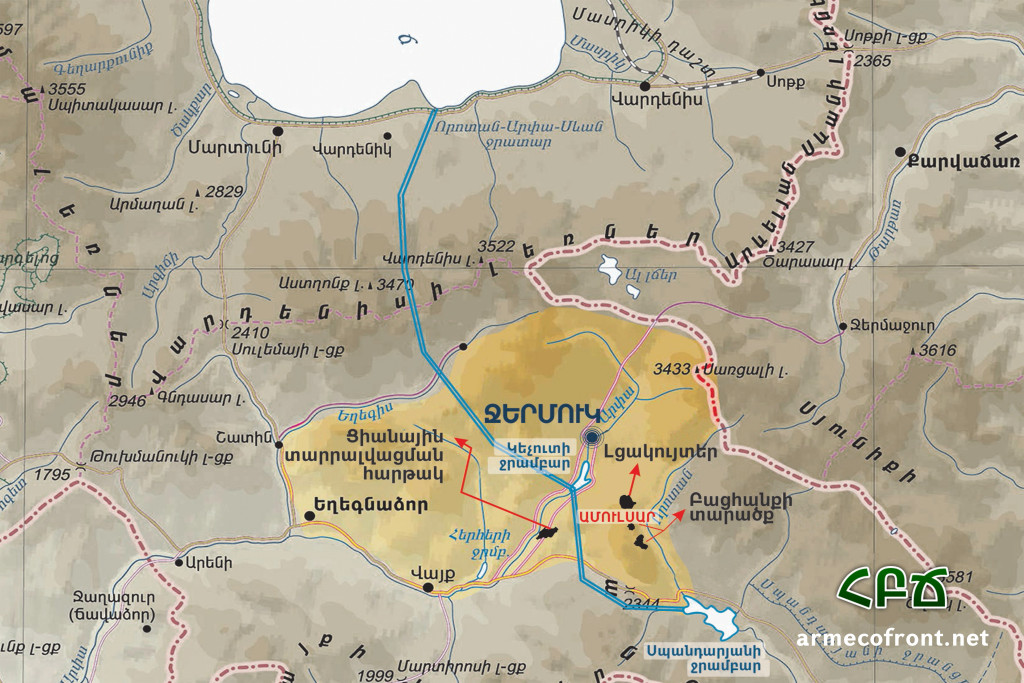“Responsible” Plunder of Nature: Problems Covered up by Lydian Regarding Exploitation of a Mine in Amulsar
Business and Human Rights Resource Center turned to Lydian International, a company that intends to exploit a gold mine in Amulsar, a mountain near Jermuk, Armenia for a response to the petition initiated by Pan Armenian Environmental Front (PAEF) civil initiative and 27 other organizations. Lydian published its response, the first few lines of which declare that our petition contains disinformation. Although this offshore company tries to substantiate its statement, we consider this an attempt to mislead the Armenian public and the international community by vilifying the arguments and activities of Armenia’s environmentalists and ecologists.
This is not the first attempt of Lydian to discredit us: three months ago the company reported to the police of Armenia accusing some of PAEF’s members for threatening the company, its employees and their families in Facebook. The police investigated this call and did not find any criminal offense. We would like to emphasize that PAEF is not responsible for the opinions expressed by other users in FB or other social platforms, and that PAEF is created as a rights-based initiative and acts within the frames of international human rights and national law. We will continue our activities against permissions to exploit Amulsar gold mine and any other new metal mine in Armenia together with other interested organizations, experts and individuals.
Now let us briefly comment on Lydian’s response.
There is no need to prove that any mining activity, especially metal mining and processing, irreversibly damages nature and human health, and this makes mining industries substantially different from the other economic activities of the humans. For many years mining companies were trying to insist that the so-called “sustainable mining” can avoid damaging the nature. Now that it is difficult to justify this argument any longer, new terminology is incorporated – “responsible mining.” This phrase is paired with attractive terms such as economic growth, paid taxes, creation of jobs, corporate profit and social projects and is used as a blatant cover-up of the real threats and public criticism. It is particularly dangerous for countries like Armenia with small area, impoverished population and authoritarian or corrupt government.
By declaring itself a pioneer in “responsible mining,” Lydian uses international soft terminology, writes volumous reports, funds some projects to buy the consent of the immediately impacted communities, and all of this is done to divert people’s attention from what is important.
The important point is that any mining activity has numerous risks. Some of these risks can be managed. But other risks are not manageable despite all the beautiful statements made in the environmental and social impact analysis reports. Moreover, these risks have nothing to do with standards promulgated by international investing institutions and organizations to which companies like to refer when they prepare reports (to save space here, we will cover the issue of EBRD and IFC standards separately; because practically, they are not exploitation standards but are rather blanket and ambiguous internal investment regulations).
Together with independent specialists, scientists, experts, environmentalists and locals, we are convinced that Amulsar gold mine project contains unmanageable risks which directly threaten Armenia’s ecological and national security (some of the experts’ opinions, analysis and articles can be found here in English).
Now let us eloborate on the serious unmanageable risks;
1. Lake Sevan and Vorotan-Arpa-Sevan water tunnel will be at stake, since the open mine area will be exposed to snow, rain and artificial watering, the streams from which will penetrate deep into the ground. Amulsar mountain is formed of cracked volcanic rocks and there is no method or technology to stop the water from penetrating into these rocks and thus flowing further into the ground. It is a sulphide mine, therefore the water flowing through sulphide rocks will turn into reactive acid water. The latter will not only erode the iron concrete construction of the Vorotan-Arpa water tunnel that is located next to the mining area, but will also mix with the water flowing through the tunnel into Lake Sevan and will ultimately alter the lake’s chemical composition. This risk is also confirmed by a fact that not far from the mining site, right on Amulsar’s slope there is a small natural pond of diluted acid. Doctor in Geological Sciences professor Armen Saghatelyan presents these unmanageable risks in details (here).
2. Dust, filled with heavy and dangerous metals, will spread around with the wind to the neighboring areas and will pollute the air, soil, surface waters, meadows, high quality pastures (by the way, the Armenian government received a loan from the World Bank for developing those pastures and thus Armenia’s population has to return the loan for already non-existing pastures), agricultural crops and wild plants. Lydian states that 95% of the dust will not move further than adistance of 1000 meters; however international and local experiences prove the opposite. For example Masrik river bottom substrate is already polluted with the dust emitted from Sotk open mine which is situated 30kms away from the river. Therefore Arpa, Vorotan and Darb rivers, as well as Spandaryan and Kechut water reservoirs which feed Vayots Dzor and Syunik regions will be at risk.
3. Another risk is associated with Jermuk, a health resort town famous for its healing mineral waters. Lydian excludes any negative impact of the mining activities on the mineral waters and insists that an isotope analysis confirmed that these waters have no physical connection to Amulsar’s water systems. However, scientific data says the opposite: in relatively recent geological past, this area was the paleochannel of the Arpa-Vorotan river basin. Vorotan river was connected to the Arpa river basin, they were one river. Vorotan river’s upper basin and Arpa river were separated after Amulsar’s lateral raise. This means that deep mineral and underground waters are still connected. Mining explosions in this area expose highly probable risks which have been analyzed by geologist Ruben Yadoyan (see here).
Lydian also mentions in its response that Jermuk resort-town is located 14 km away from the mine, although in various official documents it mentions a 7-8 km distance. The company compares Amulsar with Criple Creek and Victor mine in the USA which is only one kilometer far from the neighboring town. However, this comparison is misleading; Lydian either seems to forget or does not know that Criple Creek mine has been exploited since 1890 and the town was established to serve the mine (see details here), while Jermuk was built as a resort town and was granted a status of health resort throughout Armenia and the entire Soviet Union. Sadly, Armenian public officials, too support projects of suspicious offshore mining companies instead of promoting opportunities of harmonious coexistence with the nature. If Amulsar mine is exploited, Jermuk can no longer be a health and family resort. The locals as well as many independent experts share this opinion.
4. And finally, regarding the usage of sodium cyanide for heap leaching. This method contains primary and secondary risks, which are often unmanageable and uncontrollable. Primary risks include fires in cyanide storehouses, accidents in technical structures, leaks of highly hazardous substances, natural disasters, terrorist and military actions, and other similar accidents with grave effects on people, as well as nature (read more on these specific risks here). Secondary risks have even more complex origins and their impacts may last forever. Ore containing gold and silver is crushed as a result of which all elements (or metal and non metal compounds) in the ore are separated. This substance is processed with water and cyanide mixture, and as a result of chemical reaction the gold is separated. However the reaction takes place not only between cyanide and gold but also between cyanide and other elements in the ore, including heavy metals, as a result of which nitrates and other chemical compounds are formed. There are many more heavy metals in the ore in Amulsar than gold, including cobalt, copper, iron, nickel, mercury, zinc, wolfram, bismuth, chromium, lead, as well as poisonous substances such as arsenic, selenium, tellurium, beryllium, cadmium, which will seriously pollute and threaten nature, ecosystem and humans health if they remain in the waste (see more on the volume of other heavy metals here).
This method is used not because it is safe or innovative, but because only through cyanide heap leaching can gold be extracted in ores with little composition of gold, such as Amulsar (about 0.7 gram/tone), also because it is the most profitable method. Meanwhile, the exploitation of Bellavista mine next to Costa Rica’s Miramar residence and the accident that happened there 10 years ago show some of the technical problems and leaks that may also occur in the heap leach facility that will be located on the shores of Apra river and some 1000 meters away from Gndevaz village. Risks are even higher and pollution will be even larger in the case of Amulsar, because its territory is larger and it is located in a seismic area, in a tectonically active and landslide zone. Even a few millimeters of ground movement annually will be enough to destabilize the protective layers and structures and to cause an ecological disaster in Vayots Dzor region.
On our website we have numerously alerted of environmental as well as social risks of the Amulsar gold mining project. It does not comply with the standards of the very financial institutions who are giving the loan to this project (WB International Finance Corporaiton, EBRD), and it is a pending question why our complaints regarding this matter are not properly investigated by these institutions. Lydian and its partners continue referring to these financial institutions and their “ standards” in order to cover-up for the risks of such projects, although we can clearly witness negative environmental and social impacts of similar projects in various parts of the world; some of such hazardous projects have been supported by EBRD and IFC (here is an example).
Therefore, trendy terminology, names and standards of international financial institutions cannot be a safeguard against the abovementioned unmanageable risks of Amulsar project. Lydian itself avoids speaking about the serious shortcomings of its project and tries to shift the conversation towards other less significant points.
Pan-Armenian Environmental Front (PAEF) civil initiative
Website armecofront.net/
Facebook page facebook.com/armecofront
YouTube channel youtube.com/user/armecofront
Email address armecofront@gmail.com








